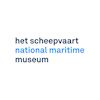
11. Noord 0, Republic at Sea: The Secret Navy in the Port of Flushing
Here we see the port of Vlissingen in the year 1805. In the foreground on the left-hand side, the commander of the fleet, VerHuell, is accompanied by a number of naval officers. There are dozens of small vessels in the harbour. A striking detail is that the flag raised on the mast of the warship in front of the church is not the Dutch flag, but the French tricolour. At the end of the eighteenth century, the Dutch Republic had gone into decline. In 1795, it fell into French hands and the Batavian Republic was proclaimed, as a sort of puppet state of France. About 10 years later, the emperor Napoleon Bonaparte asked his ally, the Netherlands, to help him with his plans to invade Great Britain. Nearly four hundred small ships were built clandestinely for the invasion fleet, known as the Secret Navy. The vessels sailed to the English Channel in small groups. But the invasion was called off because a significant proportion of Napoleon's own war fleet had in the meantime been beaten by the British at Trafalgar. Without that fleet, his invasion stood absolutely no chance; these ships returned to Vlissingen unused in 1809.


The National Maritime Museum
Het Scheepvaartmuseum (The National Maritime Museum) shows the strong connection between the maritime world and society as a whole, and more specifically the impact of this on the lives of many individuals. The collection of The National Maritime Museum is one of the largest and most notable maritime collections in the world with approximately 400,000 objects, including paintings, models of ships, navigation instruments, and maps of the world. Discover 500 years of Dutch Maritime history as well as its strong links to today’s society and the society of the future.
- Kattenburgerplein 1
- Amsterdam Netherlands
- (020) 52 32 222
- www.hetscheepvaartmuseum.nl
